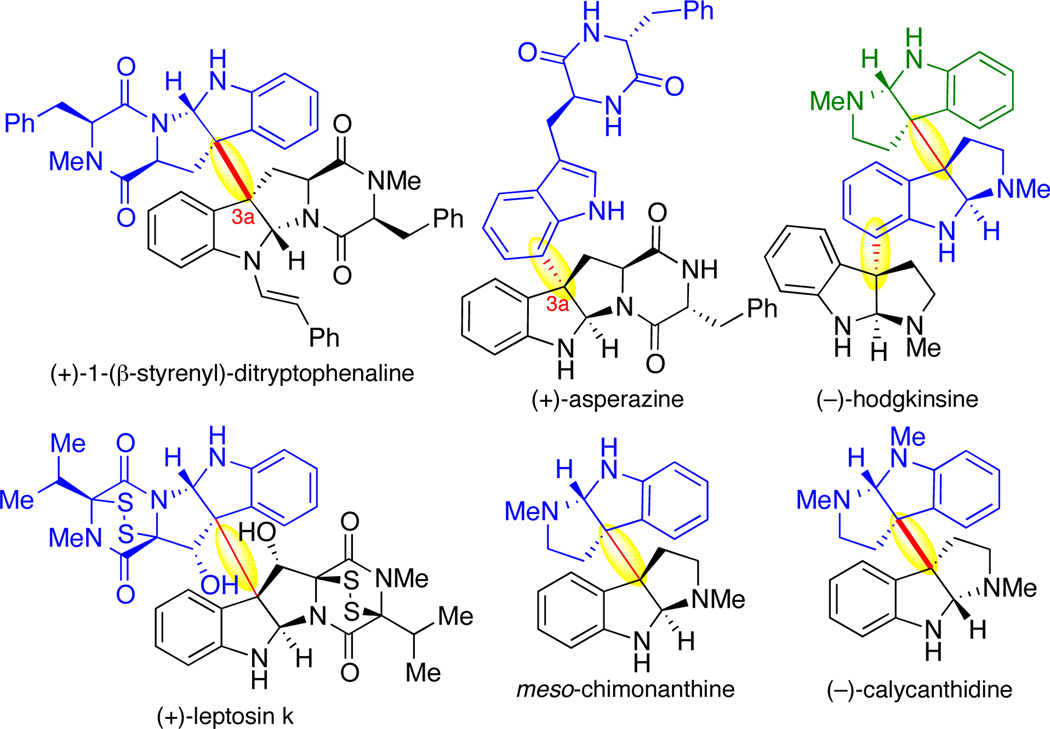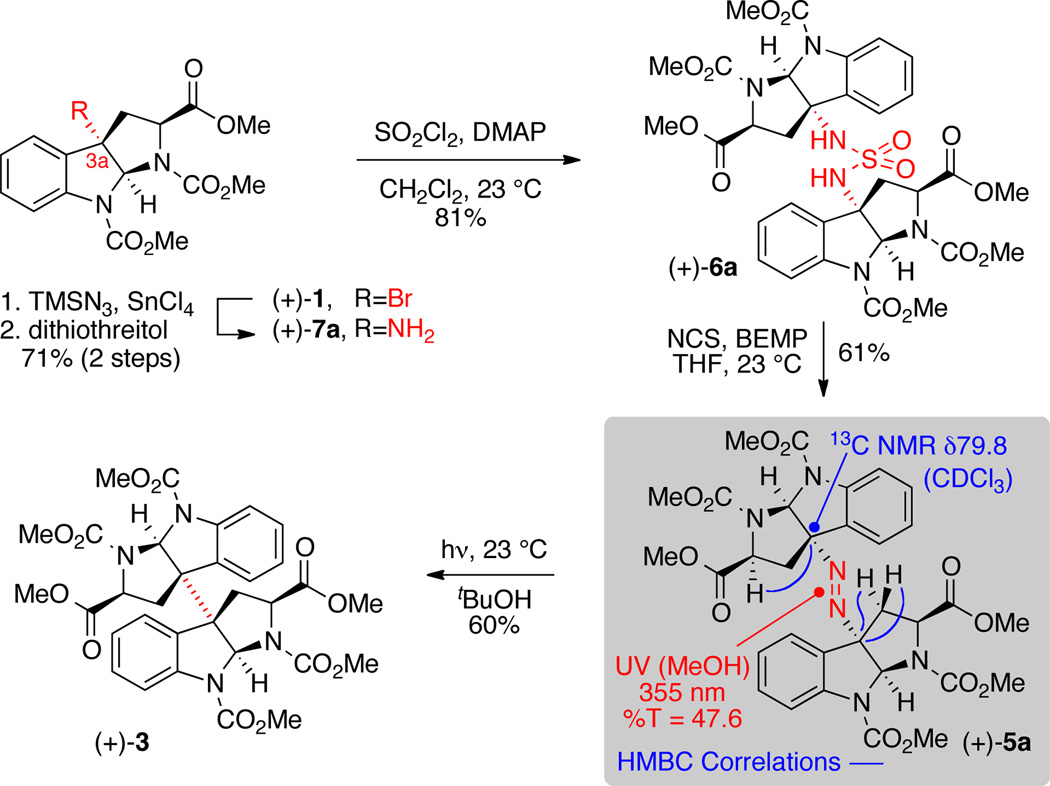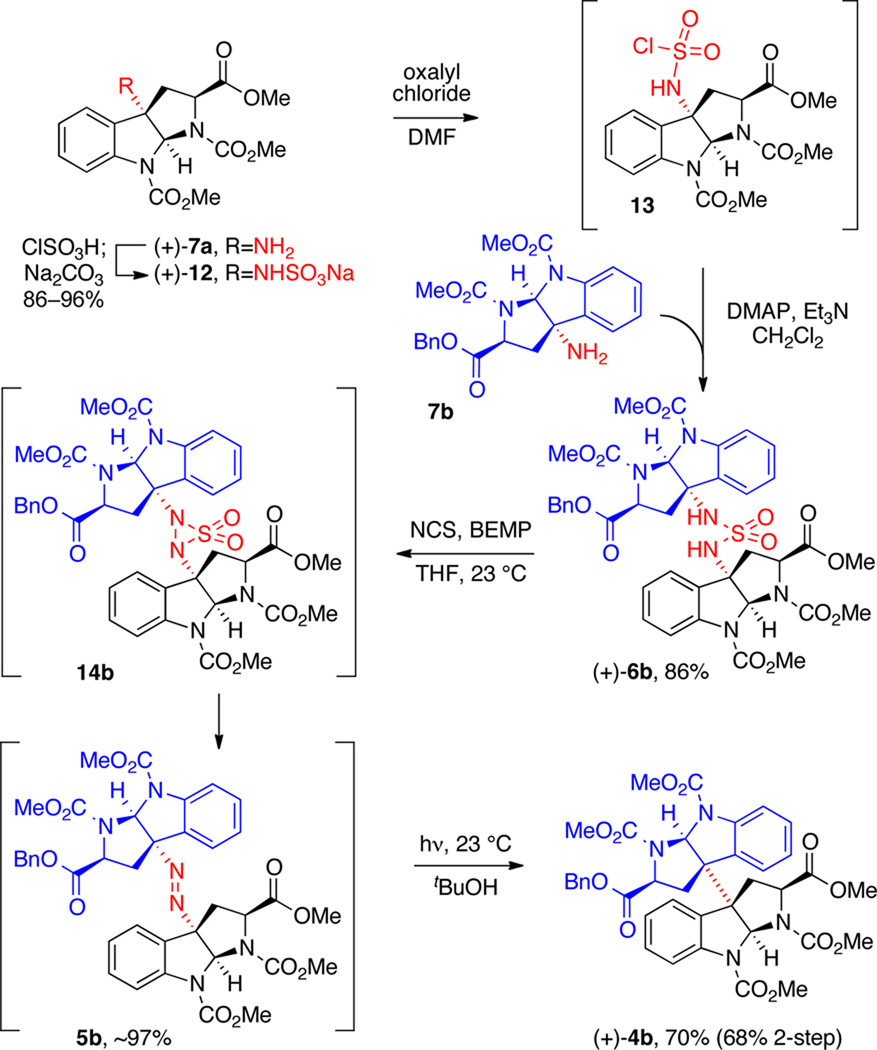Abstract
A general strategy for the directed and stereocontrolled assembly of carbon–carbon linked heterodimeric hexahydropyrroloindoles is described. The stepwise union of complex amines in the form of mixed diazenes followed by photoexpulsion of dinitrogen in a solvent–cage provides completely guided assembly at challenging Csp3–Csp3 and Csp3–Csp2 connections.
Dimeric and oligomeric cyclotryptamine and cyclotryptophan alkaloids constitute a large family of natural products with diverse molecular architectures that possess a wide range of biological activities.1 Nature is able to access an array of these alkaloids containing quaternary stereocenters at C3a through the amalgamation of various monomers. In 2007, we reported a versatile strategy for the concise and enantioselective synthesis of homodimeric cyclotryptamine substructures.2 However, to date, there are no reported methods for the selective carbon–carbon3 bond construction at the C3a quaternary stereocenter of two dissimilar cyclotryptamine subunits, a synthetically challenging structural motif found in many heterodimeric alkaloids (Figure 1).4 Herein we report a strategy for the completely stereoselective and directed union of complex fragments at these sterically crowded linkages. We demonstrate the utility of this chemistry in adjoining differing monomers at carbon–carbon fusions common to this family of natural products.
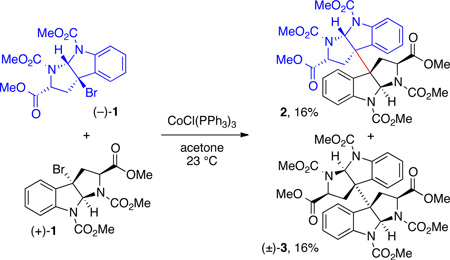 |
(1) |
Figure 1.
Representative heterodimeric cyclotryptamine alkaloids.
Our laboratory seeks effective methodology for controlled union of complex fragments for application in natural product synthesis. While our cobalt(I) promoted homodimerization of cyclotryptamine derivatives has enabled concise total syntheses,2,5 we found its extension to heterodimerization problematic. For example, uncontrolled dimerization of tricyclic bromide (+)-1 and (−)-1 using our cobalt promoted strategy provides the desired heterodimeric meso-2 in only 16% isolated yield (eq 1). The near-statistical product mixture of 2 and 3 also contains the corresponding disproportionation and related byproducts which hampers the isolation of pure heterodimer 2.6 The low yield of the desired product along with complications associated with side product formation restricts the use of this chemistry in preparative heterodimeric assembly. A maximally convergent solution to heterodimeric molecules requires a method that provides a single product with minimal influence of substrate bias in the planned union.
Inspired by the work of Bartlett, Engel, and Naumann,7 we considered the possibility of using diazenes as traceless linkers8 and radical precursors for our desired heterodimerization chemistry. Dialkyl diazenes are known to undergo expulsion of dinitrogen upon photoexcitation to generate two radical species. However, in these cases7b radical combination is accompanied by varying amounts of disproportionation. Furthermore, photoexcitation of unsymmetrical diazenes are often complicated by crossover products due to out-of-cage coupling,7f,l,m thus limiting their utility in fragment assembly and complex molecule synthesis.
We envisioned the expulsion of dinitrogen from an unsymmetrical diazene 5 (Scheme 1) to form a pair of carbon centered radicals whose directed union in a solvent-cage9 would result in selective formation of the desired heterodimer 4. The use of the mixed sulfamide 6 as the precursor10 to the unsymmetrical diazene 5 would provide a platform for the directed assembly of the two differing monomeric amines 7 and 7' (Scheme 1). Implementation of this strategy in complex synthesis would require: a) synthesis of cyclotryptamine based mixed sulfamides,11 b) mild conditions for their conversion to the corresponding unsymmetrical diazenes followed by fragmentation,12 c) solvent-cage controlled radical pair combination,9 and d) minimization of out-of-cage coupling (homodimerization) and disproportionation.7
Scheme 1.
A general strategy for directed heterodimerization.
Our initial studies focused on the evaluation of the use of dialkyl diazenes in the context of homodimerization. In this regard, we began with the development of a diazene based synthetic route to homodimer (+)-3 (Scheme 2). We developed a versatile entry to the necessary amines 7 (Scheme 1) by derivatization of the corresponding benzylic bromides that had been utilized in our cobalt promoted dimerization studies. As illustrated in Scheme 2, exposure of the bromide (+)-16 to tin tetrachloride and trimethylsilyl azide followed by reduction of the corresponding azide13 provided the desired hexahydropyrroloindolyl amine14 (+)-7a (71%). Exposure of amine (+)-7a to sulfuryl chloride provided the sulfamide (+)-6a in 81% yield. Under optimal conditions, subsequent oxidation of sulfamide (+)-6a with N-chlorosuccinimide in the presence of 2-tert-butylimino-2-diethylamino-1,3-dimethylperhydro-1,3,2-diazaphosphorine on polystyrene resin (BEMP) generated the desired diazene (+)-5a in 61% isolated yield.15 Detailed structural analysis of this symmetrical diazene was consistent with prior reports of simpler dialkyl diazenes. Specifically, the UV absorption at 355 nm and the 13C NMR resonance of the C3a of diazene (+)-5a were in accord with previously reported data for dialkyl diazenes.16 Gratifyingly, photoexcitation17 of diazene (+)-5a led to expulsion of dinitrogen and formation of the desired dimeric hexacycle (+)-3 in 60% yield. It should be noted that the overall efficiency of the process is increased (48% over two steps) when the freshly prepared crude diazene (~99%, based on 1H NMR with internal standard) is used in the following step without chromatographic purification.
Scheme 2.
Homodimer Synthesis via Diazene Fragmentation.
Having established the viability of using the sulfamide (+)-6a as a precursor to homodimer (+)-3, we turned our attention to the development of a general method for directed heterodimerization. Stepwise sulfonylation of different hexahydropyrroloindolyl amines was expected to provide a means for assembly of a heterodimeric structure as the prelude to the construction of the desired linkage. The selective synthesis of mixed sulfamide (+)-6b is illustrated in Scheme 3. Treatment of amine (+)-7a with chlorosulfonic acid followed by addition of sodium carbonate afforded the corresponding sodium sulfamate salt (+)-12.11a Sequential in situ activation of 12 to form the sulfamoyl chloride 13, followed by direct union with complex amine 7b provided the unsymmetrical sulfamide (+)-6b (86%, based on 7b, Scheme 3). Exposure of the sulfamide (+)-6b to N-chlorosuccinimide provided the corresponding unsymmetrical diazene 5b, likely via the transient thiadiaziridine dioxide 14b. The crude diazene 5b was subjected to photo-induced expulsion of dinitrogen to exclusively afford the desired heterodimer (+)-4b in 68% yield from the sulfamide (+)-6b. The optimal conditions involved irradiation using a medium pressure mercury vapor lamp in tert-butanol18 as solvent in a Pyrex® reaction vessel. Importantly, neither of the two possible homodimeric products was observed by HPLC analysis of the crude product mixture.19 Notably, the formation of heterodimer (+)-4b (Scheme 3) constitutes the first example of directed and stereoselective carbon–carbon bond construction fusing two different cyclotryptamine fragments at vicinal quaternary stereocenters.
Scheme 3.
Directed assembly and heterodimer synthesis.
The exclusive formation of heterodimeric product (+)-4b suggests exquisite control in the solvent-caged coupling of the radical pair formed upon dinitrogen expulsion from the dialkyl diazene 5b. We sought opportunities to probe the level of control exerted by this strategy in the guided unification of complex monomers. Exposure of an equal mixture of symmetrical sulfamides 6a and 6c to the two-step sequence for oxidation and fragmentation afforded only an equal mixture of the respective homodimeric products 3 and 15 (55% and 51% yield, respectively). Notably, HPLC analysis of the crude product mixture against authentic samples of 3, 4b, and 15 did not reveal any of the heterodimeric product 4b.6
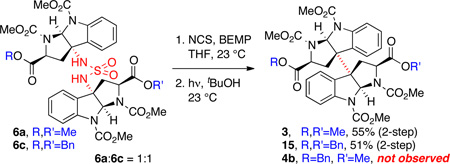 |
(2) |
Furthermore, photoexpulsion of dinitrogen from (+)-5a in the presence of 1,4-cyclohexadiene (5.0 equiv), a hydrogenatom donor, resulted in an almost equal mixture of the desired dimeric product (+)-3 (45% yield) and the corresponding monomeric C3a-H reduction product (21% yield, ~1:1 molar ratio).6 An increase in the amount of hydrogen-atom donor (1,4-cyclohexadiene, 20 equiv) afforded a similar molar ratio of product (+)-3 (41% yield) to monomeric C3a-H reduction product (20% yield). For comparison, under our reported cobalt–mediated dimerization conditions,2 bromide (+)-1 exclusively provided the monomeric C3a-H reduction product in the presence of 1,4-cyclohexadiene (5.0 equiv, 54%; 20 equiv, 82%).6 The formation of the dimer as the major product even in the presence of excess hydrogen-atom donor and at higher dilution under our photochemical conditions is consistent with solvent-cage directed radical-pair combination.
Having found conditions for the synthesis of the desired heterodimeric product we sought to further examine the scope of this process. Gratifyingly, mixed sulfamides 6d–6i (Table 1) were readily prepared using the optimal conditions described above (Scheme 3). In each case the more readily available amine was converted to the corresponding sulfamoyl chloride, allowing for the directed assembly of the heterodimeric sulfamides. Exposure of mixed sulfamides 6d–6i to the optimized oxidative diazene synthesis afforded the heterodimeric diazenes 5d–5i (Table 1). The crude diazenes were subject to photochemical expulsion of dinitrogen and gave the desired dimeric products (+)-4d–4i and meso-2.
Table 1.
Directed heterodimer synthesis.
| Entry | Unsymmetrical Sulfamidea | Diazeneb | Heterodimeric Productc |
|---|---|---|---|
| 1 | 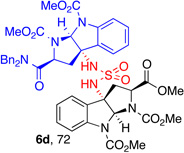 |
5d, (80) | 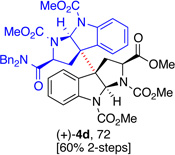 |
| 2 | 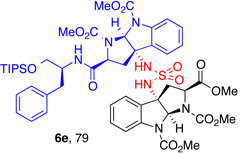 |
5e, (88) | 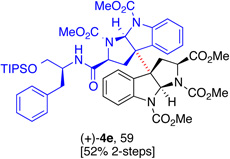 |
| 3 | 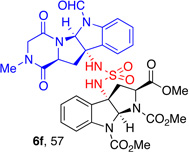 |
5f, (83) | 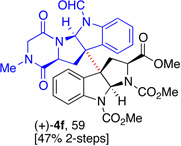 |
| 4 | 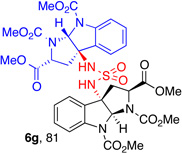 |
5g, (99) | 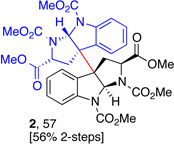 |
| 5 | 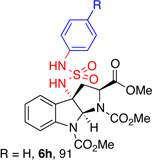 |
5h, (91)d | 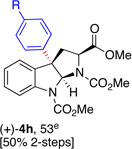 |
| 6 | R = CF3, 6i, 57 | 5i, (99) | (+)-4i, 61 [60% 2-steps] |
Mixed sulfamide synthesis: 7, 13, DMAP, Et3N, CH2Cl2, 0 → 23 °C. Isolated % yield of 6 after chromatography.
Diazene synthesis: BEMP, NCS, THF, 23 °C. Crude % yield of sensitive diazene 5 in parentheses.
Heterodimer synthesis: t-BuOH, hν >280 nm, 23 °C, 5 h. Isolated % yield of 4 after chromatography. Yield of 4 from 6 in brackets.
DBU, NCS, MeOH, 0 → 23 °C.
hν 300 nm, 12 h.
Notably, this strategy allows access to complex heterodimers such as products (+)-4e and (+)-4f. Specifically, heterodimer (+)-4f results from the fusion of a tetracyclic diketopiperazine with a cyclotryptamine moiety. Thus, the chemistry described here offers the first solution for directed and exclusive heterodimeric union of requisite dissimilar cyclotryptamine precursors. Coupling the enantiomeric amines (+)-7a and (−)-7a afforded the meso-sulfamide 6g (Table 1, entry 5), which upon oxidation and photolysis provided cleanly and exclusively the corresponding meso-dimer 2 (56% over two steps), a structural core found in meso-chimonanthine,4e (+)-leptosin K,4d and many other cyclotryptamine natural products.20 The exclusive formation of meso-2 in 28% overall yield from tricyclic bromides (+)-1 and (−)-1 can be directly compared to the example described in equation 1.
Furthermore, we wanted to explore the applicability of this methodology to the synthesis of C3a-aryl substituted quaternary stereocenters. The Csp3-Csp2 connectivity between cyclotryptamine substructures is found in many natural alkaloids (Figure 1).1 Notably, our cobalt promoted dimerization chemistry is not applicable to such unions. We were delighted to find that replacement of one of the amine components with an aniline derivative provided access to mixed aryl–cyclotryptamine sulfamides (Table 1, entries 5–6).6,21 Oxidation and photolysis provided the corresponding arylated hexahydropyrroloindoles (+)-4h and (+)-4i. The efficiency of the dinitrogen expulsion from N-aryl N'-cyclotryptaminyl diazenes 5h22 and 5i were on par with mixed diazenes 5d–5g. Current efforts are directed at broadening the scope of this methodology by developing milder methods for converting complex mixed aryl-alkyl sulfamides to the corresponding diazenes.23
We have developed a general strategy for the stereoselective directed synthesis of dimeric substructures found in hexahydropyrroloindole alkaloids. Our findings constitute the first controlled coupling of different cyclotryptamine monomers at quaternary carbons, and is distinct from prior strategies based on desymmetrization chemistry.24 The adjoining of readily available monomers in the form of mixed sulfamides enables access to unsymmetrical diazenes. Photochemically induced expulsion of dinitrogen from diazenes 5 followed by solvent-cage controlled union of the corresponding radical pair delivers the desired heterodimeric products 4 with exquisite selectivity. The described protocol allows for the selective synthesis of heterodimeric products in four operations from the corresponding amines while only requiring purification of the mixed sulfamides and final products after photolysis. This chemistry allows directed heterodimerization at important substructure linkages, particularly the challenging Csp3-Csp3 connections, found in this family of heterodimeric complex alkaloids. This completely stereocontrolled and directed fragment coupling draws on the versatility of diazene chemistry7,25 and holds great potential for complex molecule assembly.
Supplementary Material
Acknowledgement
We acknowledge financial support by NIH-NIGMS (GM089732), Amgen, and DuPont. M.M. is a Camille Dreyfus Teacher-Scholar. O.K.A. acknowledges an Amgen summer graduate fellowship. We thank Mr. Justin Kim and Dr. Nicolas C. Boyer for helpful discussions.
Footnotes
Supporting Information. Experimental procedures, spectroscopic data, copies of 1H and 13C NMR spectra, and related mechanistic studies. This material is free of charge via the Internet at http://pubs.acs.org.
References
- 1.(a) Cordell GA, Saxton JE. In: The Alkaloids: Chemistry and Physiology. Manske RHF, Rodrigo RGA, editors. Vol. 20. New York: Academic Press; 1981. pp. 3–294. [Google Scholar]; (b) Hino T, Nakagawa M. In: The Alkaloids: Chemistry and Pharmacology. Brossi A, editor. Vol. 34. New York: Academic Press; 1989. pp. 1–75. [Google Scholar]; (c) Crich D, Banerjee A. Acc. Chem. Res. 2007;40:151. doi: 10.1021/ar050175j. [DOI] [PubMed] [Google Scholar]; (d) Steven A, Overman LE. Angew. Chem., Int. Ed. 2007;46:5488. doi: 10.1002/anie.200700612. [DOI] [PubMed] [Google Scholar]
- 2.(a) Movassaghi M, Schmidt MA. Angew. Chem. Int. Ed. 2007;46:3725. doi: 10.1002/anie.200700705. [DOI] [PubMed] [Google Scholar]; (b) Movassaghi M, Schmidt MA, Ashenhurst JA. Angew. Chem., Int. Ed. 2008;47:1485. doi: 10.1002/anie.200704960. [DOI] [PubMed] [Google Scholar]; (c) Kim J, Ashenhurst JA, Movassaghi M. Science. 2009;324:238. doi: 10.1126/science.1170777. [DOI] [PMC free article] [PubMed] [Google Scholar]; (d) Kim J, Movassaghi M. J. Am. Chem. Soc. 2010;132:14376. doi: 10.1021/ja106869s. [DOI] [PMC free article] [PubMed] [Google Scholar]
- 3.For inventive total syntheses of natural products employing a key carbon(3a)–nitrogen bond construction, see: Newhouse T, Baran PS. J. Am. Chem. Soc. 2008;130:10886. doi: 10.1021/ja8042307. Newhouse T, Lewis CA, Eastman KJ, Baran PS. J. Am. Chem. Soc. 2010;132:7119. doi: 10.1021/ja1009458. Espejo VR, Rainier JD. Org. Lett. 2010;12:2154. doi: 10.1021/ol100672z. Pérez-Balado C, de Lera ÁR. Org. Biomol. Chem. 2010;8:5179. doi: 10.1039/c0ob00531b.
- 4.(a) Eccles RG. Proc. Am. Pharm. Assoc. 1888;84:382. [Google Scholar]; (b) Anet EFLJ, Hughes GK, Ritchie E. Aust. J. Chem. 1961;14:173. [Google Scholar]; (c) Barrow CJ, Sedlock DM. J. Nat. Prod. 1994;57:1239. doi: 10.1021/np50111a008. [DOI] [PubMed] [Google Scholar]; (d) Takahashi C, Minoura K, Takeshi T, Numata A, Kushida K, Shingu T, Hagishita S, Nakai H, Sato T, Harada H. Tetrahedron. 1995;51:3483. [Google Scholar]; (e) Varoglu M, Corbett TH, Valeriote FA, Crews P. J. Org. Chem. 1997;62:7078. doi: 10.1021/jo970568z. [DOI] [PubMed] [Google Scholar]
- 5.For other recent applications, see: Pérez-Balado C, de Lera AR. Org. Lett. 2008;10:3701. doi: 10.1021/ol8013073. Pérez-Balado C, Rodríguez-Graña P, de Lera AR. Chem. Eur. J. 2009;15:9928. doi: 10.1002/chem.200901056. Iwasa E, Hamashima Y, Fujishiro S, Higuchi E, Ito A, Yoshida M, Sodeoka M. J. Am. Chem. Soc. 2010;132:4078. doi: 10.1021/ja101280p. Foo K, Newhouse T, Mori I, Takayama H, Baran PS. Angew. Chem., Int. Ed. 2011;50:2716. doi: 10.1002/anie.201008048.
- 6.See Supporting Information for details.
- 7. Horner L, Naumann W. Liebigs Ann. Chem. 1954;587:93. Nelsen SF, Bartlett PD. J. Am. Chem. Soc. 1966;88:137. Nelsen SF, Bartlett PD. J. Am. Chem. Soc. 1966;88:143. Timberlake JW, Alender J, Garner AW, Hodges ML, Özmeral C, Szilagyi S. J. Org. Chem. 1981;46:2082. Hossain MT, Timberlake JW. J. Org. Chem. 2001;66:6282. doi: 10.1021/jo010212u. For other pioneering work in the area of diazene chemistry see; Porter NA, Marnett LJ. J. Am. Chem. Soc. 1972;95:4361. Gölitz P, de Meijere A. Angew. Chem. Int. Ed. 1977;16:854. Porter NA, Dubay GR, Green JG. J. Am. Chem. Soc. 1978;100:920. Baldwin JE, Adlington RM, Bottaro JC, Kolhe JN, Newington IM, Perry MWD. Tetrahedron. 1986;42:4235. Sumiyoshi T, Kamachi M, Kuwae Y, Schnabel W. Bull. Chem. Soc. Jpn. 1987;60:77. Neuman RC, Jr, Grow RH, Binegar GA, Gunderson HJ. J. Org. Chem. 1990;55:2682. Engel PS, Pan L, Ying Y, Alemany LB. J. Am. Chem. Soc. 2001;123:3706. doi: 10.1021/ja003914u. Hoijemberg PA, Karlen SD, Snaramé CN, Aramendía PF, García-Garibay MA. Photochemical & Photobiological Sci. 2009;8:961. doi: 10.1039/b902272d. For relevant reviews see: Engel PS, Steel C. Acc. Chem. Res. 1973;6:275. Engel PS. Chem. Rev. 1980;80:99.
- 8.We also explored the use of diacyl peroxides and diacyl diazenes. For diacyl peroxides, see: Bartlett PD, Leffler JE. J. Am. Chem. Soc. 1950;72:3030. Feldhues M, Schäfer HJ. Tetrahedron. 1985;41:4213. Spanttulescu MD, Jain RP, Derksen DJ, Vederas JC. Org. Lett. 2003;5:2963. doi: 10.1021/ol035125y. Jain RP, Vederas JC. Org. Lett. 2003;5:4669. doi: 10.1021/ol035859a. For diacyl diazenes, see: Leffler JE, Bond WB. J. Am. Chem. Soc. 1956;78:335. Cramer R. J. Am. Chem. Soc. 1957;79:6215. Mackay D, Marx UF, Waters WA. J. Chem. Soc. 1964:4793.
- 9.(a) Nodelman N, Martin JC. J. Am. Chem. Soc. 1976;98:6597. [Google Scholar]; (b) Braden DA, Parrack EE, Tyler DR. Coordin. Chem. Rev. 2001;211:279. [Google Scholar]
- 10.We also examined the oxidation of dialkyl ureas. For pioneering work on diaziridinones, see: Greene FD, Stowell JC. J. Am. Chem. Soc. 1964;86:3569. and. Greene FD, Stowell JC, Bergmark WR. J. Org. Chem. 1969;34:2254.
- 11.(a) Audrieth LF, Sveda M. J. Org. Chem. 1944;9:89. [Google Scholar]; (b) Hansen NC. Acta. Chem. Scand. 1963;17:2141. [Google Scholar]; (c) Weiss G, Schulze G. Liebigs Ann. Chem. 1969;729:40. [Google Scholar]; (d) Kloek JA, Leschinsky KL. J. Org. Chem. 1976;41:4028. [Google Scholar]; (e) Timberlake JW, Ray WJ, Jr, Stevens ED, Cheryl KL. J. Org. Chem. 1989;54:5824. [Google Scholar]
- 12.(a) Ohme R, Schmitz E. Angew. Chem. Int. Ed. 1965;4:433. [Google Scholar]; (b) Golzke F, Oberlinner GA, Rüchardt C. Nouv. J. Chim. 1977;1:169. [Google Scholar]; (c) Chang H-H, Weinstein B. J. Chem. Soc., Perkin Trans. 1. 1977:1601. [Google Scholar]; (d) Ikeda H, Hoshi Y, Namai H, Tanaka F, Goodman JL, Mizuno K. Chem. Eur. J. 2007;13:9207. doi: 10.1002/chem.200700820. [DOI] [PubMed] [Google Scholar]
- 13.For a base promoted introduction of azide and p-MeC6H4 at C3a of a related cyclotryptophan, see Espejo VR, Li X-B, Rainier JD. J. Am. Chem. Soc. 2010;132:8282. doi: 10.1021/ja103428y.
- 14.For a recent synthesis of C3a-amino cyclotryptamines, see Benkovics T, Guzei IA, Yoon TP. Angew. Chem., Int. Ed. 2010;49:9153. doi: 10.1002/anie.201004635.
- 15.Application of previously reported conditions was found to suffer from incomplete conversion or low yield of the diazene.
- 16.Key spectroscopic data for representative diazenes: α, α'-azocumene, λmax = 367 nm (ref. 7b), 13C NMR (CDCl3) δ 71.32 (α-carbon, ref. 12d); trans-N,N'-di(1-adamantyl)diazene, λmax = (octane) 368 nm (ref. 7k).
- 17.Photoexcitation at 23 °C was found to be superior to thermal diazene fragmentation for our substrates. For example, diazene (+)-5a was stable at 120 °C in DMSO-d6 while resulting in unproductive decomposition at 150 °C.
- 18.The use of methanol, a lower viscosity solvent, resulted in a drastic decrease in the isolated yield of the desired product.
- 19.Samples of the homodimeric products were readily available by our cobalt chemistry.
- 20.(a) Hart NK, Johns SR, Lamberton JA, Summons RE. J. Aust. Chem. 1974;27:639. [Google Scholar]; (b) Libot F, Miet C, Kunesch N, Poisson JE, Pusset J, Sévenet T. J. Nat. Prod. 1987;50:468. [PubMed] [Google Scholar]; (c) Verotta L, Pilati T, Tatø M, Eilsabetsky E, Amador TA, Nunes DS. J. Nat. Prod. 1998;61:392. doi: 10.1021/np9701642. [DOI] [PubMed] [Google Scholar]; (d) Jannic V, Guéritte F, Laprévote O, Serani L, Martin M-T, Sévenet T, Potier P. J. Nat. Prod. 1999;62:838. doi: 10.1021/np9805387. [DOI] [PubMed] [Google Scholar]
- 21.Sulfamides 6h and 6i were prepared from the corresponding aniline derived sulfamate salts and amine 7a.
- 22.Diazene 5h was found to undergo facile trans to cis isomerization in solution (CD3CN) upon exposure to ambient light. Interestingly, a majority of cis diazenes have been shown to be unstable above 0 °C in solution (see ref 7f and 7o).
- 23.Complications during the sulfamide to diazene conversion using our current conditions prevent the use of electron rich anilines; see Forster DL, Gilchrist TL, Rees CW. J. Chem. Soc., Perkin Trans. 1. 1971:993. in addition to refs. 7f and 7h.
- 24.For an elegant example of desymmetrization chemistry in a related system, see Kodanko JJ, Overman LE. Angew. Chem. Int. Ed. 2003;42:2528. doi: 10.1002/anie.200351261. Also, see refs. 2b, 5a, and 5d.
- 25.For representative examples of intramoleular carbon–carbon bond formation using dialkyl diazene intermediates in natural product synthesis, see: Little RD, Carroll GL, Pettersen JL. J. Am. Chem. Soc. 1983;105:928. Little RD. Chem. Rev. 1996;96:93. doi: 10.1021/cr950017d. Mascitti V, Corey EJ. J. Am. Chem. Soc. 2004;126:15664. doi: 10.1021/ja044089a. Wender PA, Kee J-M, Warrington JM. Science. 2008;320:649. doi: 10.1126/science.1154690.
Associated Data
This section collects any data citations, data availability statements, or supplementary materials included in this article.



